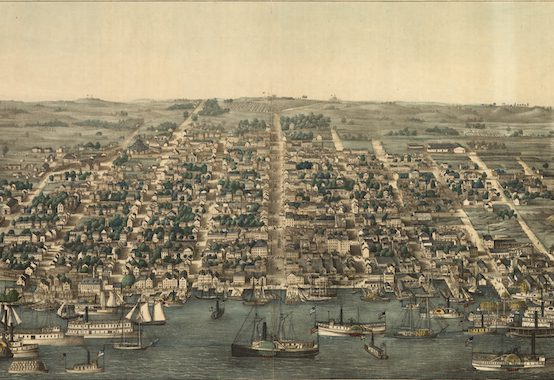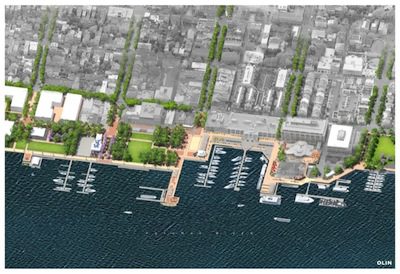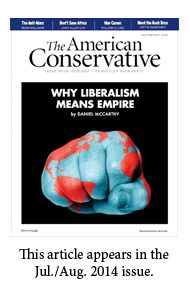The Battle of Alexandria

Alexandria, Virginia, is one of the oldest towns in America: founded in 1749, tradition has it that a 17-year-old George Washington helped the county surveyor lay out its original 60 acres. For the next 100 years, Alexandria was one of the busiest ports in the country, a hub of national and international commerce. Its traditional architectural landscape became a model for many towns throughout the 19th and early 20th centuries.
But Alexandria, just south of Washington, D.C., is no mere relic of a bygone America—it’s also a model for New Urbanism, a movement that arose in the early 1980s to reinstitute a more traditional town structure across America. New Urbanist towns possess a tightly knit neighborhood design in which shops, houses, offices, and apartments sit side-by-side. They boast an interconnected grid with a hierarchy of streets, boulevards, and alleys, all narrow enough to create a walkable environment. Public spaces are focused in the center of the city. These qualities describe Old Town Alexandria perfectly—it’s the organic exemplar of what New Urbanists aim to cultivate and preserve. Indeed, Alexandria served as host for the first Congress for the New Urbanism in 1992.
Yet Alexandria’s waterfront, once a bustling commercial harbor on the west bank of the Potomac, today poses a problem. The fertilizer and fish warehouses, coal- and lumberyards of its industrial sector are mostly gone, but a couple remain, bookending the waterfront from north and south. They were sold to developers last September, and their demolition will result in substantial changes to the area—including the construction of two boutique hotels, new residences, and retail shops along the water.
From the beginning, city planners have run into passionate opposition to this “waterfront project.” Its immense scale, its alteration of the city’s current block structure, and its effect on street widths and traffic threaten to efface the qualities that have long made Alexandria a model of American urbanism.
Bert Ely, co-chair of the Friends of the Alexandria Waterfront coalition and a self-described “moderate libertarian,” believes in increasing commercial opportunities in Old Town—but he is also zealous for the town’s traditional character. “If you want to live in this unique area, understand the rules put in place,” he said. “These developers coming in want to try and capitalize on the spirit of what’s here, but in the process they may destroy it.”
To understand why the proposed changes are so contentious, one must first appreciate Old Town Alexandria. Aside from its historical significance, its enduring beauty is an attraction to thousands of tourists and residents alike. It has preserved the cobblestone streets, gaslit lamps, narrow roads, and colonial stonework of the colonial era. The street names themselves suggest as much: the city’s main boulevard is King Street, a bustling channel of commerce and civic life. Yet even at its busiest, King Street still conveys small-town charm—the coffee shop baristas smile at familiar faces, young families amble by with their strollers, and locals carry shopping bags to the weekend farmer’s market. Stepping onto Prince Street, the residential avenue just south of King, ushers pedestrians into a still point where lamps flicker in front of buildings of stone and brick, and old trees shade passersby.
The waterfront could unquestionably use some revamping. The remaining large warehouses are aesthetically jarring. They also obstruct some of the best views. They also obstruct the Mt. Vernon Trail, a paved path that extends all the way to George Washington’s historic home, some 18 miles long. Opening up more views to the water and developing the Mt. Vernon Trail would extend a great service to locals and visitors alike. The new hotels planned as part of the redevelopment would also bring the city some $750,000 in annual property taxes, according to the Washington Post’s Patricia Sullivan, a considerable step up from the present $42,000 the city presently receives from the area.
But the parks and hotels that are the keystones of the development plan have a less innocuous side. About two years ago, Peter Katz, the founding executive director of the Congress for the New Urbanism, went down to Alexandria and looked at the city’s waterfront plan. He recommended that planners “make more of the plaza, keep the streets open, don’t be too timid about developing the real estate aggressively, and get some revenue coming in.” But he has been disappointed by the planners’ departure from Alexandria’s traditional block structure and their continued preference for large, open parks over new retail opportunities.
Blocks make up more than just the body of a city; they give rise to its character. Streets in Old Town are set in a style known as the “perimeter block,” which is important mainly for what it conceals: perimeter blocks are edged with row houses or commercial storefronts, but the interior of these blocks contains space for alleyways, rear gardens, garages, dumpsters, and service entrances. These blocks have kept Alexandria’s streets walkable. Katz calls them the “normal vocabulary of Old Town.”
Traditionally, Alexandria’s grid was made up of perimeter blocks all the way down to the water’s edge. But the Olin Group, a Philadelphia development firm currently redesigning the Alexandria waterfront, instead plans a series of shallow blocks that will run alongside a swath of renovated public parks on the waterfront. Every park will have standing capacity for over 500 people—and most can hold over 1,000. One of them—Waterfront Park, just south of King Street—will include an area for concerts or outdoor movies.

Creating a series of lovely large public parks may seem unobjectionable. But even parks must maintain a sense of scale. “When you bring too much activity to the water’s edge and over-program it,” Katz warns, “you’ll find that when the project’s new and exciting, it will function for a few years” but before long “waterfronts become very tired.” Unlike city squares and central parks that have “neighborhood fabric on all sides,” activity on a waterfront comes from only one direction, and too many parks create a sense of desolation.
Katz suggests that a single park at the foot of King Street would be enough. “I’d rather see one well-done place that would be bursting with activity when it’s busy, and when not busy, will still feel occupied.”
The two boutique hotels that developers plan for the new waterfront at the north and south terminals pose other problems of scale and traffic. The southern hotel, developed by Carr Hospitality, will be five stories, with 120 rooms and a restaurant. The Friends of the Alexandria Waterfront coalition doesn’t approve of that size: though the hotel is within the height limit set by the city, “the mass and scale of the Carr hotel clearly exceeds that of its neighbors,” FAW’s website warns.
A hotel of 120 rooms is small by the standards of most places. But King Street’s commerce is traditionally tiny. Alexandria’s boulevards are dotted with boutiques and independent restaurants—there are few fast-food chains or large retail stores. And the closer one gets to the water, the more compact the space becomes.
Alexandria Board of Architectural Review member Peter Smeallie voted against the hotel mainly for reasons of scale. “Our job is to make sure that whatever goes in, goes in with concert and respect [for] the old and historic district,” he said in a phone interview. “That involves scale, and mass, and architecture.” But fellow board member and art history professor Oscar Fitzgerald contends that the hotel’s architecture properly looks somewhat like a warehouse. He argues that the structure, while large, is complementary to the idea of a formerly working waterfront.
But critics believe that the developers are not keeping in mind the physical constraints imposed by Alexandria’s narrow streets, sidewalks, and limited parking. Some fear that the waterfront project will turn Old Town into a crowded, touristy place. “It’s not just about the preservation of historic structures,” FAW’s Ely says. “It’s also the preservation of this walkable community, and not having it overwhelmed by traffic.”
Skip Graffam, an Olin Group designer, hopes to counteract such overcrowding and an influx of automobile traffic by elevating the streets to curb level at intersections along the waterfront. This, he believes, will create a plaza effect, giving pedestrians a feeling of freedom and prompting drivers to proceed more conscientiously. “Because of the materials and quality, drivers will see that this is not a road, this is a pedestrian space,” he says.
That might work—if the streets are narrow enough, argues Philip Bess, a professor in the school of architecture at the University of Notre Dame and a leading figure in New Urbanism. Raised streets are a common feature in Europe: in Bruges, Belgium, most canal streets don’t have traffic lights or stop signs. Streets are shared by pedestrians, cars, bicycles, and buses. “The wider the streets, the faster cars want to go,” Bess notes. “It’s a great blessing to have narrow streets, from a New Urban and pedestrian point of view. The narrower the streets, the more they can be shared.”
What happens, though, when Alexandria’s narrow streets become congested with traffic and pedestrians who congregate on the waterfront rather than circulate along the old blocks? 
Ely contends that Old Town’s colonial beauty and walkability are largely a result of accident—because the town was founded at a time when the popular street grid and house size made for “a wonderful, urban, walkable community.” The “constant battle” that citizens fight today, he says, is to preserve the status quo. “So many communities have tried to replicate what we got by accident,” he said. “And we’re fighting like hell to keep it.”
This isn’t the first time Alexandrians have had to do so. In the mid-1960s, the city’s leadership decided to remake the colonial town into a “modern city.” Market Square, an area where public markets have been held since the town’s founding, was cleared of its 18th- and 19th-century buildings (except City Hall) and the block was excavated to hide a parking garage under the square. But “as the wrecking balls swung,” says the city’s website, “Alexandria’s preservation movement grew, forcing city government to protect some community landmarks.” Among the buildings saved and restored were Carlyle House, a stone, 18th-century Palladian-style home that now hosts school programs, exhibits, and lectures on pre-Revolutionary Alexandria, and the Lyceum, an 1839 Greek Revival building that today serves as a local history museum, and which was the venue for that first New Urbanism congress 20 years ago.
As America grew and changed after World War II, urban planners dismissed the historic structure of town life. Old buildings were demolished to make way for modern architecture. Neighborhoods gave way to suburbs designed around and for the automobile. Not only did this erase the aesthetic loveliness of our towns, it had dangerous consequences for community. Alexandria’s battle to preserve something small and traditional amid the burgeoning sprawl of the nation’s capital region is a struggle with obvious parallels to the efforts of traditionalist conservatives around the country—those who believe in creative preservation, not just creative destruction. But there’s more at stake here, too: a future for American urbanism that doesn’t just hold onto the best of the past but makes it a viable, enlivening pattern for the 21st century as well. Redevelopment must be handled with a delicate touch, careful not to stretch or tear the precious fabric that makes a town a place.
Gracy Olmstead is an associate editor of The American
Conservative. This article was supported by a grant from The Richard H. Driehaus Foundation.
Comments